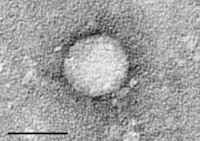
Photo from wikipedia
To ensure efficient propagation, viruses need to rapidly produce viral proteins after cell entrance. Since viral genomes do not encode any components of the protein biosynthesis machinery, viral proteins must… Click to show full abstract
To ensure efficient propagation, viruses need to rapidly produce viral proteins after cell entrance. Since viral genomes do not encode any components of the protein biosynthesis machinery, viral proteins must be produced by the host cell. To hi‐jack the host cellular translation, viruses use a great variety of distinct strategies. Many single‐stranded positive‐sensed RNA viruses contain so‐called internal ribosome entry sites (IRESs). IRESs are structural RNA motifs that have evolved to specific folds that recruit the host ribosomes on the viral coding sequences in order to synthesize viral proteins. In host canonical translation, recruitment of the translation machinery components is essentially guided by the 5′ cap (m7G) of mRNA. In contrast, IRESs are able to promote efficient ribosome assembly internally and in cap‐independent manner. IRESs have been categorized into four classes, based on their length, nucleotide sequence, secondary and tertiary structures, as well as their mode of action. Classes I and II require the assistance of cellular auxiliary factors, the eukaryotic intiation factors (eIF), for efficient ribosome assembly. Class III IRESs require only a subset of eIFs whereas Class IV, which are the more compact, can promote translation without any eIFs. Extensive functional and structural investigations of IRESs over the past decades have allowed a better understanding of their mode of action for viral translation. Because viral translation has a pivotal role in the infectious program, IRESs are therefore attractive targets for therapeutic purposes. WIREs RNA 2018, 9:e1458. doi: 10.1002/wrna.1458
Journal Title: Wiley Interdisciplinary Reviews: RNA
Year Published: 2018
Link to full text (if available)
Share on Social Media: Sign Up to like & get
recommendations!